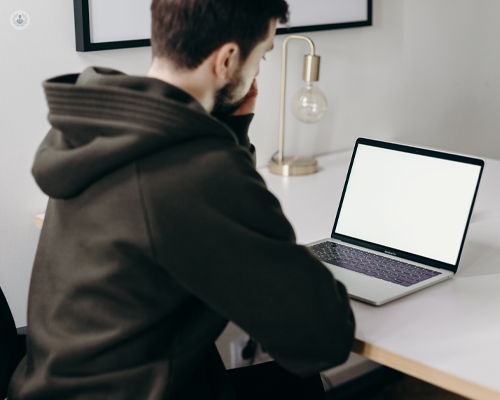Back pain and working from home during COVID: Causes, risks and how to prevent it
Written by:Back pain is a common health concern and new risks have arisen due to the increase in people working from home during the current Coronavirus pandemic.
Leading consultant spinal surgeon Mr Sanjay Dhiran has provided his expert opinion on what can cause back problems for people who are working at home, as well as the main triggers of back pain and ways to combat it.

What are the main causes of back pain?
Most people generally refer to back pain as lower back pain, although it can be anywhere from the neck down to the lower back.
Lower back pain is an extremely common problem that most people experience at some point in their life. Most back pain is non-specific and are termed `mechanical´. It tends to settle down in a few days or weeks.
The structures that can generate pain in the lower back include intervertebral discs, facet joints, muscles and bones. Common causes include degenerative conditions. These are also referred to as `wear and tear´, or more specifically; arthritis, spondylitis and degeneration. These terms are used by different specialists who see patients with back pain. These include
- GPs;
- specialist nurses;
- osteopaths;
- chiropractors, and;
- physiotherapists.
Most spinal surgeons would use the term ´Degenerative spine disease´.
Other serious causes of back pain include infection, tumours, trauma (fractures) and instability-related conditions such as spondylolisthesis and spondylolysis. These are diagnosed by asking the patient about their relevant history, examination and specialist investigation.
How might people’s backs be affected whilst working from home?
Working from home has been an evolving concept over the last few years especially with growing concerns regarding climate change. The current COVID-19 pandemic has accelerated the need to work from home, keeping in mind the concept of social distancing to reduce community transmission of the virus.
Office-based work environments are well researched and appropriate ergonomic concepts are put in place to reduce the harmful effects of desk-based jobs on the back and overall health. These include: appropriate lighting and ventilation, open-plan office, appropriate height of the working desks, chairs, foot rests and many modifications employed by occupational health services for specific individual needs.
Most homes are designed for relaxation, with some including a smaller area used as a study for the occasional work from home situation. Inadequate working space, ill-fitting chairs (for work purposes), inadequate lighting and ventilation will have an effect on the human body and particularly lower back or neck on a long-term basis. There will be a tendency to gain weight because of lack of social inhibition around food habits. Also, sleep patterns may change. All of these factors pose a significant risk to the human body and the lower back and neck, in particular.
What is the best way to prevent back pain when working from home?
Working from home has presented the challenge of recreating an appropriate working environment to prevent common conditions such as back pain. It is easy to start work from a sofa, bed or a kitchen table. It may not cause any major effect on our back if it is for a day or two but it is quite possible this will become a common feature of our work culture in the future. Therefore, it is important to make appropriate changes to allow working from home without causing serious effects on the human body, particularly the lower back.
These include:
- Setting up a regular place to work, depending on appropriate lighting conditions, good ventilation and minimal sound interference.
- Appropriately-sized work desks and office stationery within easy reach. When sitting, elbows should be at 90 degrees to the body and shoulders in a neutral position. Standing desks which allow for their heights to be adjusted can be marked to return to constant height when used in a sitting position. If you are sitting for longer period of time, use a foot stool to adapt half-a-step position to reduce strain on the lower back.
- Good, ergonomic chairs. Chair height should be adjusted to allow the knees to be slightly lower than the hips. The back should be supported well though adjustable height and tilt. Use a lumbar support if necessary. Foot rests can be used.
- Computer screens should be at eye level, an arm’s length away.
- Set a fixed start and end time plus breaks, if possible. As working from home presents the possibility to be flexible with time, it´s easy to fall in the trap of bad time management.
- Taking regular breaks to relax and stretch your back muscles
- Monitoring food/calorie intake. It is easy to neglect good food habits while working from home.
- Adequate hydration.
If back pain persists, what might it mean?
Lower-back pain tends to settle down within a few days to 4 to 6 weeks. You have to seek further medical advice if:
- Pain persists and interferes with work and activities of daily living
- You have pain at night or it interferes with sleep
- Pain is radiating down one or both legs
- Pain is associated with urinary symptoms such as inability to initiate (hesitancy) or control (incontinence)
- Saddle anaesthesia (numbness around back passage or groin region)
- Fever
- Unexplained weight loss
- Thoracic pain
- Previous serious illness (cancer, infection)
- Recent trauma/fall
- Low-energy fall or use of steroids for other illness
What are the best treatment options for back pain?
Most back pain responds to simple pain killers such as paracetamol, short-term use of anti-inflammatory medications and simple modifications of daily activity. It is important to check with your doctor or pharmacist if medications are suitable in case of other medical conditions you are being treated for.
It´s advisable to keep the back as mobile as possible. Rest appears to make back pain worse because muscles aren´t being used, which can make the lower back stiff.
- Physiotherapy-based stretching exercises, developing core strength and review of body posture is helpful, especially on a long-term basis
- Spinal injections may be helpful in the process of being diagnosed. However, they are more useful if there is associated pain radiating down the leg (nerve pain)
- Specialist treatments, such as back-pain rehabilitation through functional restoration programmes, require referral to a specialist back-pain management service. The services provided include group exercise classes, cognitive behavioural therapy (CBT) and spinal injections
- Surgical treatment for back pain is currently not advisable based on NICE guidelines. However, it´s important to look for any signs of spinal instability in which case, surgical option can be explored particularly if it is associated with neural compression
Is surgery for back conditions still going ahead during this pandemic?
Spinal surgery for emergency conditions such as spinal cord compression, cauda equina compression and spinal tumours causing fractures and instability continue to be performed during the pandemic, although there was additional risk of patients contracting the COVID-19 infection during their stay in the hospital.
Spinal surgery for non-emergency conditions were put on hold because of the priority need of hospital services for COVID-19 patients, some undergoing life-threating complications. As the pandemic has progressed with a downward slope of `waves´, some of the non-emergency services have been resumed, starting with spinal injections for nerve root blocks and epidural injections.
Mr Sanjay Dhiran is available to assist you with your back pain queries and spinal concerns. Find out more about his leading spinal surgery services via his Top Doctors profile.


